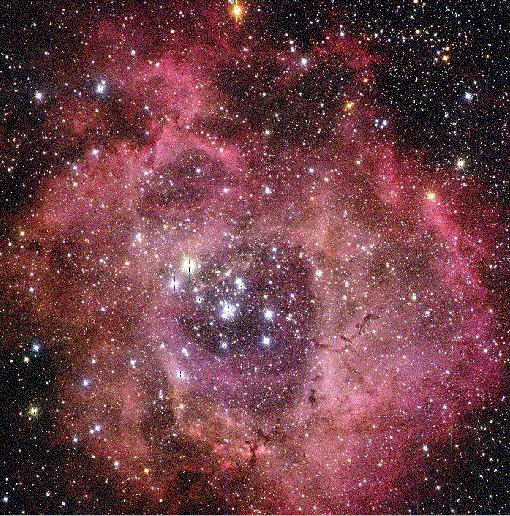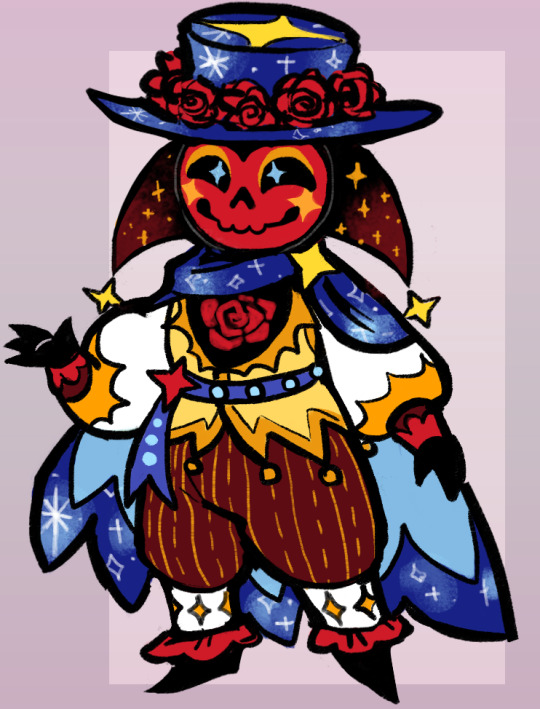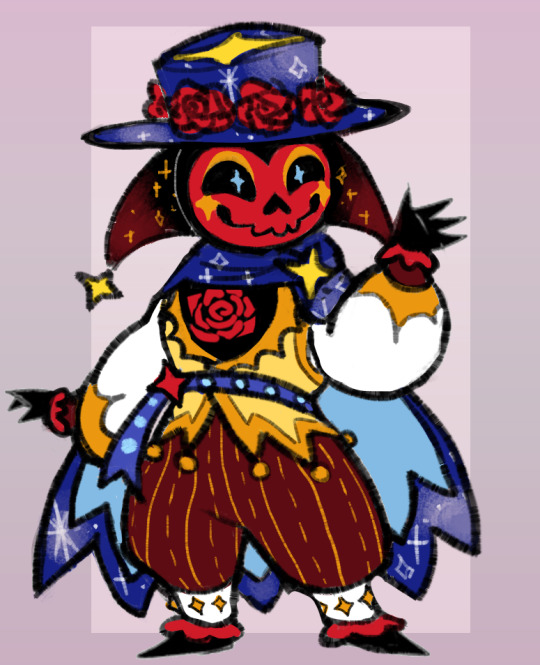#NGC 2244
Explore tagged Tumblr posts
Text

The Rosette Nebula, C49 // Dudás László
At the center of this nebula that stretches 130 light years across is an open star cluster known as the Satellite Cluster (NGC 2244). It is the hottest stars in this cluster that are ionizing the gas surrounding them, resulting in the beautiful Rosette Nebula we see. It was English astronomer John Flamsteed (1646-1719) that found the Satellite Cluster.
#astronomy#astrophotography#caldwell catalog#nebula#emission nebula#star-forming region#rosette nebula#satellite cluster#open cluster#star cluster#stars#NGC 2237#NGC 2238#NGC 2239#NGC 2244#NGC 2246#Sh2-275#caldwell 49#C49#monoceros
73 notes
·
View notes
Text

NGC 2244 - Rosette Nebula !
Courtesy: Bill Blanshan
#art#cosmos#cosmic#universe#blast#space#wallpaper#photography#stars#nebula#rosetta nebula#NGC 2244#bill blanshan
28 notes
·
View notes
Text

Photo of the NGC 2237, the Rosette nebula and the star cluster inside it, NGC 2244.
The star cluster, which is estimated to be about 5 million years old, is responsible for the ionisation of the surrounding gas. The mass of the nebula is estimated to be about 10 000 times the mass of our sun, which is relatively massive for a diffuse nebula.
This image uses a SHO palette, I quite like the colours I manage to get, both as the normal and starless images.

I also tried using the Foraxx palette, I think it's a bit less interesting visually, but the dark dust structures seam a bit more visible.

(Image taken using a CarbonStar 150/600 newtonian telescope with a 0.95 coma corrector, ZWO ASI294 monochrome camera ZWO LRGB filters and Baader 6.5nm SHO filter. 5x120s image for each colour filter (RGB), 15x300s for the Ha filter 20x300s for the SII filter and 18x300s for the OIII filter, total imaging time 4h 25min, stacking and processing done in PixInsight.)
#astronomy#astrophotography#space#nebula#Rosette Nebula#emission nebula#NGC 2237#star cluster#NGC 2244#photos taken from my backyard
3 notes
·
View notes
Text



NGC 2244, Cosmic Rose
6K notes
·
View notes
Photo

2025 February 14
A Cosmic Rose: NGC 2237 in Monoceros Image Credit & Copyright: Harry Karamitsos
Explanation: The Rosette Nebula, NGC 2237, is not the only cosmic cloud of gas and dust to evoke the imagery of flowers, but it is probably the most famous. At the edge of a large molecular cloud in Monoceros some 5,000 light years away, the petals of this cosmic rose are actually a stellar nursery. The lovely, symmetric shape is sculpted by the winds and radiation from its central cluster of hot young, O-type stars. Stars in the energetic cluster, cataloged as NGC 2244, are only a few million years young, while the central cavity in the Rosette Nebula, is about 50 light-years in diameter. The nebula can be seen with a small telescope toward the constellation of Monoceros, the Unicorn. This natural appearing telescopic portrait of the Rosette Nebula was made using broadband color filters, but sometimes roses aren't red.
∞ Source: apod.nasa.gov/apod/ap250214.html
84 notes
·
View notes
Text

The Rosette Nebula is 5,219 light years from Earth, located near one end of a giant molecular cloud in the Monoceros region of the Milky Way Galaxy. The open cluster NGC 2244 is closely associated with the nebulosity, the stars of the cluster having been formed from the nebula's matter. 90 minutes of data
#astronomy#nasa#astronomers#universe#nasa photos#astrophotography#outer space#astrophysics#nasawebb#hubble space telescope#our universe#the universe#astronomy facts#astronomy photography#astrography#nasa astronauts#i love astronomy#astronomy picture of the day#international space station#space science#sky#space exploration#space#space photography#nasa science#science facts#planetary science#science#planetary nebula#rosette
110 notes
·
View notes
Text
Skull or Rosette?

This beautiful emission nebula in the constellation Unicorn with embedded star cluster NGC 2244 is a popular target in the winter starry sky. Parts of the nebula itself were first described by various astronomers between 1830 and 1886. The star cluster inside, however, was discovered as early as 1690.
With a distance of 5219 light years and a radius of 65 light years, it is almost in our neighborhood.
Translated with DeepL.com (free version)
108 notes
·
View notes
Text

Star Cluster in the Rosette Nebula - May 22nd, 1996.
"Embedded in the center of the colourful and photogenic Rosette Nebula is a bright, young open cluster. The bright blue stars in this cluster, labelled NGC 2244, emit ultraviolet light that knocks electrons away from hydrogen atoms. When the electrons fall back, they emit the red light which distinctively defines the glow of all emission nebulae. The Rosette Nebula is thousands of light years distant, but light would take only about 100 years to cross it. The Rosette Nebula is not difficult to observe and, although faint, actually appears larger than the full Moon."
38 notes
·
View notes
Photo




(Also posted on Instagram)
My entry for @slocotion's DYO contest! This little guy is inspired by one of my favorite celestial objects, the Rosette Nebula! :]
I thought the idea of stacking a top hat on top of a jester cap might be a bit silly, but I ended up liking it more than I expected?
--
Design Concept
Rosette Nebula (Skull Nebula): The Nebula with a Hole in the Heart
Based on Caldwell 49, a nebula that resembles both a rose and a human skull. The “hole” in the center of the nebula gives it its iconic rose shape. The rose theme reminded me of a phantom thief, who I found similar to a jester in the sense that they were both witty figures and masters of tricks!
I wanted them to have a look that was both snazzy like a gentleman thief and whimsical like a jester, with a repeating "star" motif to represent the open cluster (NGC 2244) within the nebula.
--
Top text transcript:
Rhódon (Greek for "rose", a flower that, in Greek mythology, came from the lifeless body of a nymph that was transformed by Chloris) is a phantom thief who loves attention and all things shiny and sparkly!
They are constantly driven by the urge to show off their skills, and the thrill of pulling off impressive heists is one of the only things that fill the hole in their heart.
#outer space is actually one of those themes that i find myself having trouble working with#but i do enjoy how this little guy turned out!#i'll be happy keeping them as an oc tbh#my art#my design#i also like to think you can use any pronouns for this guy#there's no objectively wrong answer just like the nebula can be either a rose or skull#or a secret third thing
194 notes
·
View notes
Text

Rosette Nebula Talon Abraxas
The Rosette Nebula is a vast emission nebula located about 5,200 light years away. The star forming region lies near a large molecular cloud in the constellation Monoceros, the Unicorn. It is closely associated with the young open star cluster NGC 2244.
Also known as the Satellite Cluster, NGC 2244 appears in the centre of the Rosette. The hot young stars of the cluster were formed from the nebula’s material in the last 5 million years.
The stars in the Satellite Cluster are responsible for the nebula’s glow. Their radiation ionizes the surrounding clouds of nebulosity, causing them to emit their own light. The nebula glows in the red part of the spectrum because the powerful ultraviolet radiation from the stars strips electrons from the nebula’s hydrogen atoms.

In the Heart of the Rosette Nebula Talon Abraxas In the heart of the Rosette Nebula lies a bright cluster of stars that lights up the nebula. The stars of NGC 2244 formed from the surrounding gas only a few million years ago. A hot wind of particles streams away from the cluster stars and contributes to an already complex menagerie of gas and dust filaments while slowly evacuating the cluster center. The Rosette Nebula's center measures about 50 light-years across, lies about 5,200 light-years away, and is visible with binoculars towards the constellation of the Unicorn (Monoceros).
38 notes
·
View notes
Text

The Satellite Cluster (NGC 2244) at the heart of the Rosette Nebula (NGC 2237) // Andrea Iorio
#astronomy#astrophotography#nebula#emission nebula#star-forming region#rosette nebula#NGC 2237#NGC 2238#NGC 2239#NGC 2246#Sh2-275#stars#star cluster#open cluster#satellite cluster#NGC 2244#monoceros
192 notes
·
View notes
Text
The Rosette Nebula (Caldwell 49) in narrowband false color (SHO/Hubble palette).
The Rosette is an emission nebula (a cloud of ionized gas emitting light) in the Monoceros constellation, notable for having an open cluster of young stars (NGC 2244) at its center, formed from the gases of the nebula.
Shot with a 440mm effective focal length Newtonian telescope at a focal ratio of f/2.93, with roughly five hours of total integration time (1 hour of Ha and roughly 2 hours each of OIII and SII, exposure length varying from 3 to 5 minutes). Captured with an ASI533MM Pro camera.
Processed with SiriL, Starnet, and GIMP. Support free software.

#astronomy#space#astrophotography#deep sky#nebula#narrowband#night sky#c49#caldwell 49#rosette nebula#ngc2244#rainbow#caldwell catalog
24 notes
·
View notes
Text

The Rosette Nebula
Located 5,200light years away, is an expansive emission nebula associated with the young open star cluster NGC 2244.
Named after its rosette-like appearance, the nebula is also known as the Skull Nebula due to its resemblance to a human skull, although it should not be confused with the planetary nebula NGC 246, also called the Skull Nebula, in the constellation Cetus.
The stars in the Satellite Cluster emit radiation that ionizes surrounding nebulous clouds, causing them to glow. The nebula exhibits a red hue due to the ultraviolet radiation from these stars, which strips electrons from hydrogen atoms in the nebula.
17 notes
·
View notes
Text

NGC 2244, Rosette
2K notes
·
View notes
Photo

2024 February 14
Rosette Deep Field Image Credit & Copyright: Olivier Bernard & Philippe Bernhard
Explanation: Can you find the Rosette Nebula? The large, red, and flowery-looking nebula on the upper left may seem the obvious choice, but that is actually just diffuse hydrogen emission surrounding the Cone and Fox Fur Nebulas. The famous Rosette Nebula is really located on the lower right and connected to the other nebulas by irregular filaments. Because the featured image of Rosetta's field is so wide and deep, it seems to contain other flowers. Designated NGC 2237, the center of the Rosette nebula is populated by the bright blue stars of open cluster NGC 2244, whose winds and energetic light are evacuating the nebula's center. The Rosette Nebula is about 5,000 light years distant and, just by itself, spans about three times the diameter of a full moon. This flowery field can be found toward the constellation of the Unicorn (Monoceros).
∞ Source: apod.nasa.gov/apod/ap240214.html
131 notes
·
View notes
Text

NGC 2244- ROSETTA NEBULA
#nebula and quasar#planetary nebula#nebula#love & rockets#rosette#astronomy#nasa#astronomers#universe#nasa photos#astrophotography#outer space#astrophysics#nasawebb#hubble space telescope#space travel#international space station#space science#space exploration#space#nasa science#science facts#planetary science#space photography#science#astronomy facts#astrography#our universe#the universe#nasa jpl
95 notes
·
View notes